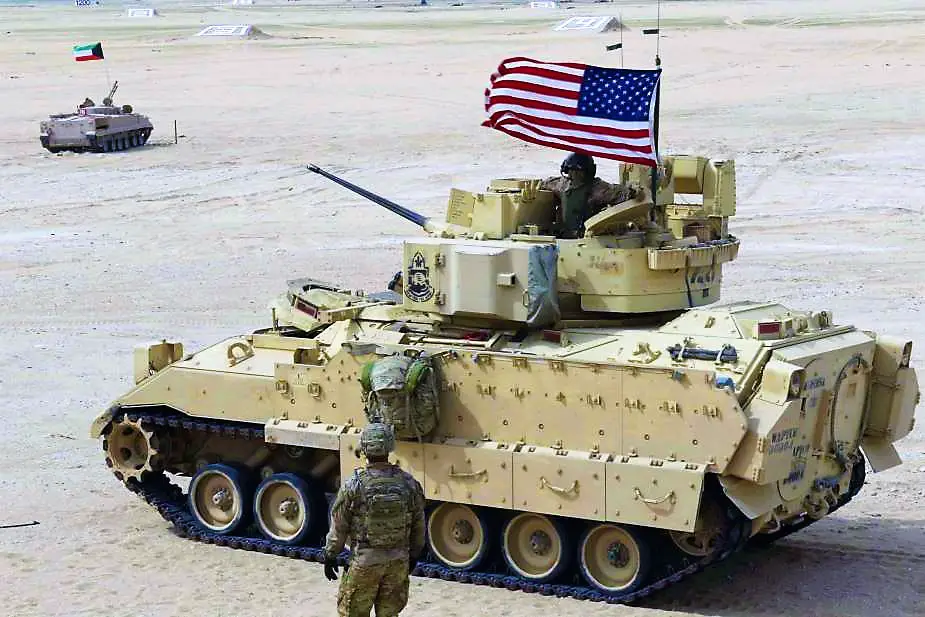General Dynamics Land Systems announced on February 16 that GM Defense, a subsidiary of General Motors, is joining its project team for the U.S. Army’s Optionally Manned Fighting Vehicle (OMFV) competition. “Our team continues to grow stronger and gain momentum as we aggressively push to provide this important capability for the Army,” said Don Kotchman, General Dynamics Land Systems vice-president and general manager of U.S. Operations. “This collaboration with commercial powerhouse GM Defense brings together world-class capabilities from both companies to meet the future needs of the U.S. Soldier operating in a multidomain environment.”
Follow Army Recognition on Google News at this link

The OMFV programme aims at replacing the M2A3 Bradley IFV (Picture source: U.S. DoD)
Aligned with the U.S. Army’s phased philosophy for the OMFV competition, General Dynamics Land Systems has implemented digital engineering processes, artificial intelligence and modular open electronic architecture into its concept for the program.
“We’re very excited to be joining General Dynamics Land Systems’ established and highly experienced OMFV program team,” said Steve duMont, president of GM Defense. “I see tremendous synergies as we seek to leverage our core capabilities in integrated vehicles, power and propulsion and mobility and autonomy to support the OMFV program. We look forward to collaborating with a great company such as General Dynamics Land Systems, as we combine and leverage our advanced technologies, digital design expertise and manufacturing scale to help produce the most capable infantry fighting vehicle for the U.S. Army warfighter.”
GM Defense joins AeroVironment, Applied Intuition and General Dynamics Mission Systems as core members of General Dynamics Land Systems’ OMFV team.
U.S. Army’s OMFV Optionally Manned Fighting Vehicle programme
The Army’s OMFV is an optionally manned platform that maneuvers soldiers to a point of positional advantage to engage in close combat and deliver decisive lethality during the execution of combined arms maneuvers. It is designed to operate with or without a crew and Soldiers under armor based on the commander's decision, while also controlling maneuver robotics and semi-autonomous systems.
In June 2018, in part due to congressional concerns, the Army announced a new modernization strategy and designated the Next-Generation Combat Vehicle (NGCV) as the program to replace the M2 Bradley. In October 2018, Army leadership decided to redesignate the NGCV as the Optionally Manned Fighting Vehicle (OMFV) and to add additional vehicle programs to what would be called the NGCV Program.
The M2 Bradley, which has been in service since 1981, is an Infantry Fighting Vehicle (IFV) used to transport infantry on the battlefield and provide fire support to dismounted troops and suppress or destroy enemy fighting vehicles. Updated numerous times since its introduction, the M2 Bradley is widely considered to have reached the technological limits of its capacity to accommodate new electronics, armor, and defense systems. Two past efforts to replace the M2 Bradley — the
Future Combat System (FCS) Program and the Ground Combat Vehicle (GCV) Program — were canceled for programmatic and cost-associated reasons.
In late 2018, the Army established Army Futures Command (AFC), intended to establish unity of command and effort while consolidating the Army’s modernization process under one roof. AFC is intended to play a significant role in OMFV development and acquisition.
On March 29, 2019, the Army issued a Request for Proposal (RFP) to the industry for the OMFV. The Army characterized its requirements as “aggressive” and noted industry might not be able to meet all requirements.
On January 16, 2020, the Army canceled the OMFV program, intending to restart the program following analysis and revision of program requirements. According to Army officials, “a combination of requirements and schedule overwhelmed industry’s ability to respond within the Army’s timeline.”
On February 7, 2020, the Army reopened the OMFV competition by releasing a new market survey with a minimally prescriptive wish list and an acquisition strategy that shifted most of the initial cost burden to the Army.
On April 9, 2020, the Army provided new OMFV program guidance to industry featuring a five-phased approach to acquisition as well as a pledge to “reduce foreign barriers to competition,” and “identify a pathway to integrate relevant but immature technologies” into the program. Reportedly, the three companies that participated in the first iteration of the OMFV competition — BAE Systems, General Dynamics Land Systems, and American Rheinmetall — are bidding for the new OMFV program. In addition, Oshkosh Defense and Hanwha Defense, a Korean company, are entering the competition too. Mettle Ops, a small defense firm with no experience building vehicles, also plans to submit a bid. Phase Two of the new competition, the Preliminary Design Phase, is planned to begin June 25, 2021, and run for 15 months.
The Army’s FY2022 OMFV Research, Development, Test and Evaluation (RDT&E) budget request is $225.106 million.















